BRACES /ORTHODENTIC TREATMENT
Most people want better looking teeth but they also don’t want people to know that they have braces or deal with the unattractiveness of having those things in your mouth for so long. You can give the appearance that you don’t have braces simply by asking for invisible braces. They are a little more expensive but they’ll get the job done, and you won’t look like a 13 year old.
Invisible braces
provide a hygienic, convenient and clear solution to irregular and crooked teeth with out having to wear brackets and wires.
Advantages:
- More comfortable compared to the use of brackets and wires.
- Hardly any one can notice that you are under going orthodontic treatment.
- Very hygienic way to treat mal occlusion as it does not let food particles get around braces.
- Easily removable allowing yu to enjoy existing eating habits with out having to modify them.
- Results are 100 % guaranteed.
Pre treatment and post treatment cases. - You have the oppurtunity to digitally review potentially corrected position of your teeth in the virtual set up.
It is an excellent tool for permanent hair reduction which saves time and money. Benefits include freedom from ingrown hair and rashes occurring during waxing or threading. Also great from hygiene point of view.
Invisble Aligners uses the original patient dentition and actual IPR combined with precision of movement to deliver the best results with better hygiene through clearer aligners.
- Comfortable
- Removable
- Snug fitting
- Easy to maintain oral hygiene
- Clearer
Invsible aligners have been proven to be successful for the correction of a variety of malocclusions, to discuss your individual case please visit your Dentist
Cost of the appliance varies depending upon severity of malocclusion, duration of treatment and the treatment plan decided by the treating Dentist
Since each malocclusion is different and the response to the treatment varies from patient to patient, so predicting actual treatment plan is difficult. Your treating Dentist will be in a better position to answer such queries. Normally the treatment time is comparable to the time taken by conventional braces.
To get Invisible aligners you need to visit your nearest general dentist providing the treatment.
While wearing appliance, it applies continuous correcting force to align teeth, so it’s empirical that the appliance is worn full time, except when brushing, eating or drinking hot and cold beverages.
At the end of treatment retainers are given to maintain the position of teeth as achieved at the end of treatment. Duration to wear retainers, in order to maintain the teeth in corrected position, varies from patient to patient and is also dependent on the type of malocclusion thus can be better prescribed by the treating Dentist.
Be in command of the treatment plan.
Cost effective
Using Original patient dentition to make the aligners During the whole manufacturing process They uses original patient dentition from casting to treatments and aligner fabrication which adds to the accuracy of the end product and ensures better treatment outcome.
More precision at every step of the treatment
Invis Align enables you to increase your standard of care. The entire process is designed to deliver customized aligner that moves each tooth directly along the most efficient path to achieve the desired goal. By optimizing each aligners output, you minimize the number of aligners and intermediate changes required that means shorter treatment times for patients, and increased capacity for practice.
Actual diagnostic setup
Invis Align provides actual diagnostic setup images for precise information regarding the desired goals.
Using original gum tissue of the patient
Invis Align uses original gum tissue to fabricate aligners, thus providing lesser number of clinical modifications at the time of insertion of aligners.
Faster turn around time
- Invis Align commits to provide aligners within 3 weeks after receiving the impression at our manufacturing facility.
- Precise space gaining through IPR of the original dentition No virtual IPR
- InvisAlign provides you precise information regarding IPR on each surface of the tooth without any digital errors
- Tesimonials, Pre and Post Treatment Photographs
ANTERIOR OPENBITE
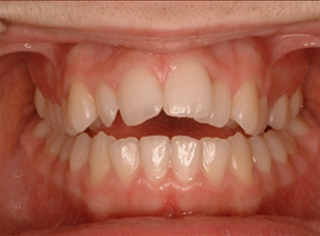
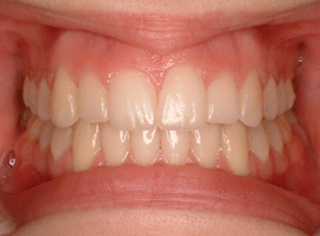
- Case Status: Completed
- Malocclusion: Class I malocclusion with upper anterior openbite
- No. of Aligners: 25 upper and 20 lower
- ClearPath Package: CPO-A
- Treatment Objectives: Relative extrusion of upper anteriors by retraction followed by extrusive attachments to finish in Ideal Overjet and Overbite.
CLASS II DIVISION 1
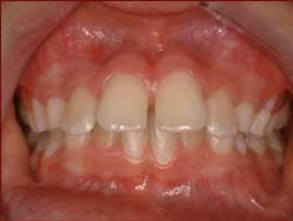
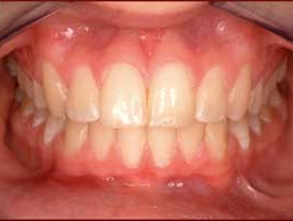
- Case Status: Completed
- Malocclusion: Class II Division 1 malocclusion
- No. of Aligners: 15 upper and 10 lower
- ClearPath Package: CPO-A
- Treatment Objectives: Upper anterior segment retraction and space closure.
CLASS II DIVISION 200 (DEEP BITE)
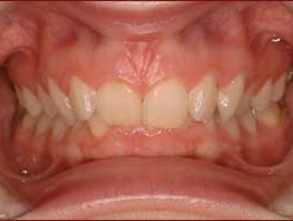
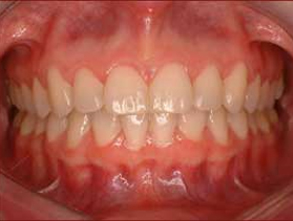
- Case Status: Completed
- Malocclusion: Class II Division 2 malocclusion
- No. of Aligners: 35 upper and 29 lower
- ClearPath Package: CPO-A
- Treatment Objectives: Correction of the overbite by upper anterior protraction and intrusion of U/L anteriors.
CLASS III MALOCCLUSION (UNDER BITE)
- Case Status: Completed
- Malocclusion: Class III malocclusion
- No. of Aligners: 35 upper and 29 lower
- ClearPath Package: CPO-A
- Treatment Objectives: Correction of the underbite, protraction of upper anteriors, leveling & alignment.
BUCCALLY PLACED CANINES
- Case Status: Completed
- Malocclusion: Class I malocclusion with buccally placed canines
- No. of Aligners: 22 upper and 14 lower
- ClearPath Package: CPO-A
- Treatment Objectives: Leveling & alignment of both arches followed by extrusion of upper canines with extrusive attachments.
CONGENITALLY MISSING LATERAL
- Case Status: Completed
- Malocclusion: Class I malocclusion with congenitally missing laterals
- No. of Aligners: 25 upper and 20 lower
- ClearPath Package: CPO-B
- Treatment Objectives: Both upper laterals were missing, canines had drifted mesially. Eruption of canines was induced and canines reshaped into lateral incisor anatomy.
ANTERIOR CROSSBITE
- Case Status: Completed
- Malocclusion: Class I malocclusion with anterior crossbite
- No. of Aligners: 25 upper and 14 lower
- ClearPath Package: CPO-B
- Treatment Objectives: Correction of anterior crossbite followed by leveling & alignment of both arches.
POSTERIOR CROSSBITE
- Case Status: Completed
- Malocclusion: Class I malocclusion with posterior crossbite
- No. of Aligners: 35 upper and 11 lower
- ClearPath Package: CPO-A
- Treatment Objectives: Arch expansion and bite jumping to correct crossbite. Followed by leveling & alignment of arches.
SEVERE CROWDING WITHOUT EXTRACTIONS
- Case Status: Completed
- Malocclusion: Class I malocclusion with crowding
- No. of Aligners: 30 upper and 21 lower
- ClearPath Package: CPO-A
- Treatment Objectives: Arch expansion, proclination and IPR were used to gain space in upper arch. Followed by leveling & alignment of both arches.
SEVERE CROWDING WITH EXTRACTIONS
- Case Status: Completed
- Malocclusion: Class II malocclusion
- No. of Aligners: 34 upper and 22 lower
- ClearPath Package: CPO-B
- Treatment Objectives: First premolar extraction to gain space. Extrusion of canine into arch form. Followed by leveling & alignment of both arches.
CROSSBITE, CROWDING & SPACING
1.Case Status: Completed
2. Malocclusion: Class I malocclusion with crowding, spacing and crossbite
3. No. of Aligners: 24 upper and 12 lower
4.ClearPath Package: CPO-A
5.Treatment Objectives: Crossbite correction, leveling & alignment of both arches.
ORTHODONTICS
Orthodontics is the branch of dentistry that deals with straightening and correcting the tooth alignment.
Today children, as well as adults, are choosing to have orthodontic treatment since age is no longer a factor that governs the feasibility of the treatment. But as you grow older the duration of the treatment is increased since it is easier to shift and align teeth during the growth phase of the jaws. Orthodontic treatment corrects -malocclusion (bite or occlusion is off) -tooth malalignment (crooked teeth).
Orthodontics is not only used to improve your appearance. Malocclusion or malaligned teeth can have long-term effects, such as:
- Interference with normal growth and development of the jaws
- Abnormal swallowing patterns
- Abnormal facial muscle function
- Impairment of chewing
- Speech defects
- Susceptibility to cavities due to the difficulty of removing plaque from crooked teeth vulnerability to accidents or fractured teeth (if your front teeth stick out, they may be more easily injured).
Teeth can slowly be moved and shifted into proper position by applying pressure in certain directions. Bands, wires and elastics are placed on the teeth to move them in the right direction. This takes place slowly and carefully over an extended period of time. Shifting teeth back into a functional position can take months to years, but eventually, you’ll have a new and improved mouth! Retainers are often used after the braces, to hold the teeth in their new position until they are stable. It is important to wear the braces or an appliance for however long it takes. If you quit at any point during treatment, the teeth can shift back into their old position.
Ceramic (Tooth Colored) Braces
Ceramic brackets are made of composite materials. They are very strong and generally do not stain. Adults like to choose ceramic because they “blend in” with the teeth and are less noticeable than metal. The ligatures (tiny rubber bands) that hold the arch wire on to the ceramic brackets are often white

or clear. This looks great at first, but the ligatures can stain. Unless you eat a lot of curry, smoke, or drink a lot of black coffee, this generally isn’t a problem. Note that the ligatures are changed each time you get an adjustment — usually, monthly. It’s only the ligatures that stain, not the brackets themselves!
Lingual Braces
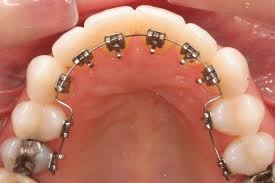
These are the ultimate in brace concealing technology. They are placed on the backs of your teeth so nobody will even see that you have them on, unless they get an up close and personal look at the inside of your mouth.
Usually, lingual brackets are made of metal.
Orthodontists need special training to be able to treat patients with lingual braces. Therefore, not every orthodontist provides them.
Metallic Braces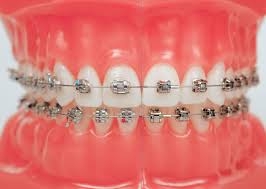
Metal brackets are the ones that are most frequently used. They appear as small metal buttons that are glued to the front of each tooth. These tend to be less expensive than other types of brackets. Additionally, they can be made colorful with ligature rubber bands that come in a wide range of colors.
A major drawback of these braces is there color which makes its use very limited in cases of adult orthodontics. .


